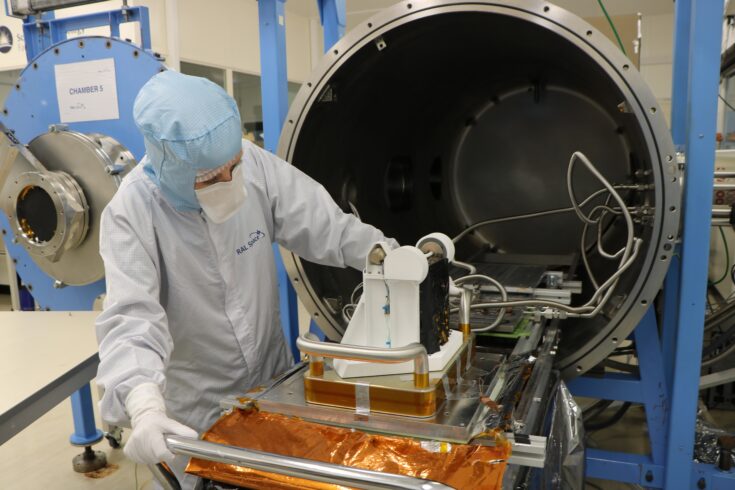A team of UK scientists are helping to investigate the occurrence and behaviour of water on the Moon.
Scientists from the Science and Technology Facilities Council’s (STFC) RAL Space and the Open University (OU) are collaborating on the European Space Agency (ESA) and NASA mission.
Understanding the lunar ‘water cycle’
Led by the OU’s Dr Simeon Barber, the UK team has developed a sensor known as the Exospheric Mass Spectrometer (EMS). The EMS is an integral part of the Peregrine Ion Trap Mass Spectrometer (PITMS), which is now being shipped from RAL Space to NASA.
The PITMS instrument is led by Dr Barbara Cohen at NASA’s Goddard Space Flight Centre and will be delivered to the Moon later by Astrobotic, one of the companies under contract for NASA’s Commercial Lunar Payload Services (CLPS) initiative.
The instrument will measure the water and other molecules in the very thin atmosphere of the Moon throughout a lunar day. This will help scientists understand the emerging concept of a lunar ‘water cycle’.
UK involvement
PITMS was developed within a very short time, using a fast-track development strategy that balanced high efficiency of instrument development with a careful risk management approach.
RAL Space was responsible for:
- the EMS overall mechanical design
- the electronic design
- instrument software
- ground support equipment.
They also worked closely with NASA on the PITMS thermal design. The OU led on the on the Ion Trap sensor.
Artemis generation
NASA’s Artemis missions combine robotic and human exploration on and around the Moon that will prepare for the next giant leap, sending astronauts to Mars. Commercial and international partners including ESA, aim to develop the first long-term presence on the Moon.
Understanding resources such as water on the Moon and learning how to use these as supplies for drinking water or rocket propellant could reduce mission costs and enable human exploration of our solar system.
The delivery of the PITMS instrument, which is a joint ESA-NASA undertaking, for its integration with the lunar lander is an important milestone. It provides a new generation of instruments that will enable Artemis to deliver its ambitious program of science and exploration.
Next steps beyond the Moon
The Apollo Moon landings originally found the Moon to be a dry place. Decades later, advanced analysis of the returned samples showed that there were small amounts of water within lunar samples.
Based on observations and modelling, the Moon likely has a complex water cycle. Water may migrate from equatorial regions, driven by extreme day-night temperature cycles, until it becomes tightly ‘trapped’ at permanently cold polar locations.
PITMS measurements will help scientists understand the source and movement of this water, which is a key open question in lunar science. This could pave the way for developing plans to harvest lunar water as a resource to support future human exploration missions and the establishment of lunar bases.
Dr Simeon Barber, EMS lead from the Open University, said:
PITMS will study how water and other molecules behave during the warm lunar daytime near a lunar lander. We will obtain ground truth measurements to fill in the detail of the broader view we already have from remote measurements by orbiters.
And then we will complete the picture using similar instruments on future landers near the cold lunar poles, where these molecules may have accumulated over billions of years to form a treasure trove of scientifically and practically valuable resources.
Chris Howe, Production and Software Group Leader at STFC RAL Space said:
We have landed a similar instrument on a comet as part of ESA’s Rosetta mission but nothing has been as challenging as developing an instrument against the backdrop of the pandemic. To have designed, built and tested a proto-flight lunar instrument in just 18 months has been a huge achievement for RAL Space and the OU.
Now we look forward to discovering more about the lunar water cycle and playing our part in furthering human exploration of the solar system.
Ellis Elliot, Project Manager at STFC RAL Space, said:
It has been a great experience to be part of such a new and different project. Although not always being easy to organise the project in a pandemic, I’ve been so proud to be part of the team and oversee their design work transforming into an instrument that will be on the moon’s surface.
The collaboration with the Open University and ESA has been very rewarding and hopefully a channel to further partnerships to build on the teams experience.
Top image: PITMS instrument completing testing at STFC RAL Space before being shipped to NASA. Credit: Open University, STFC RAL Space, NASA Goddard Space Flight Centre

